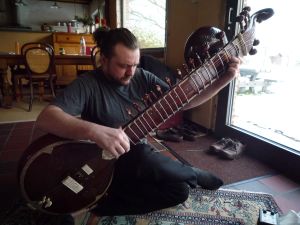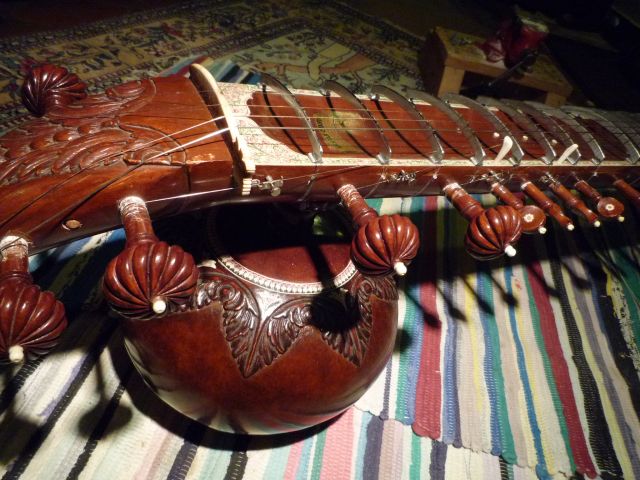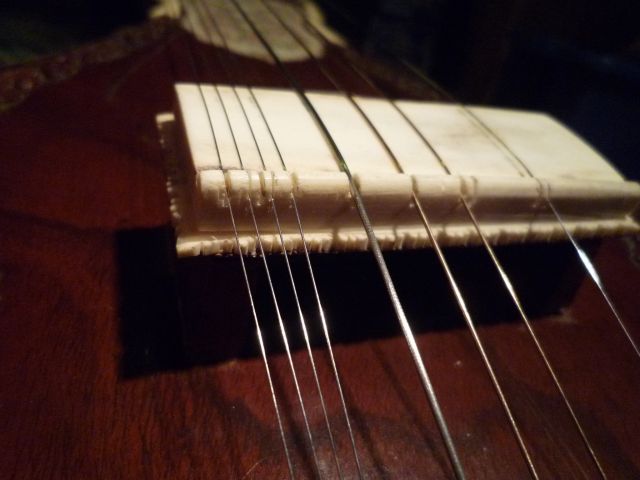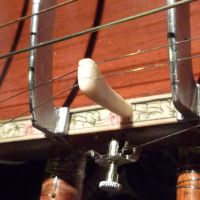Surbahar Mod: adding 4th cikari
Adding an extra cikari string to this old Kartar Chand surbahar to meet the Balaram Pathak Garana style requirements.

No new cikari kuti will be installed because of the surbahar neck construction. The imposant surbahar’s head is jointed to the neck. Therefore it is not obvious to drill an extra hole through this construction. But the solution is very simple: The first tarav kuti becomes the last cikari kuti. Since this kuti can hold every kind of string, there is no need for creating another new cikari kuti. I simply removed the first tarav string, drilled a hole in the outer kuti’s region and mounted the last cikari string to it. Optionally, later, i can always install an extra tarav kuti on the utter last position to regain the original tarav strings number.
On this instrument we have been re-directing the first (SA) cikari string under the patri. This results in an increased playing comfort concerning the Laraj Kharaj strings: no more incidental touching of the first cikari string while playing meend on the Laraj Kharaj strings.
This mod is then completed by adding an extra cikari slide on the jiwari, re-organising the cikari slide positions on the jiwari, adding an extra cikari pin and finally installing the strings itself.
The cikaris tuning is according to the raga specifications, but combinations like f.ex. Sa Dha Pa Pa do sound very nice.
Also on this surbahar, i mounted a new Kharaj string from German’s famous string maker Pyramid Strings. It is a nickel flatwound on steel .046w (1.22mm diameter). Superb string. Unheard long and deep sustain while playing meend, unrivalled tuning-stable, very soft and warm, deep bass sound. A real joy for player and listener…




I am affraid that I cannot help you with details such as evolution of their particular sitar-type from c.1890 to the present, book refs, interviews, etc… Nor the profound reasons why they have been made. I have my reservations about the effect that some changes they have carried out on their instruments really do have or not. But I think that it might be best to contact Ashok Pathak himself about this. See : ashokpathak.com
Or, you can contact his Belgian sishya Bert C. via sitarplayer.be
PS. I have tried several times to contact you via e-mail, but didn’t succeed. All mails returned “undeliverable”…???
Thank you for the reply.
Will try to follow to the letter regarding Question #3 (above).
As for Pathak Ghar sitar details, I’d like to find info on the evolution of their particular sitar-type from c.1890 to the present: book refs, interviews… ;
As for details, for ex.: string materials & tuning;# of frets used & when & why did B.Pathak added #8 & 15… ; any specs/dimensions that may stand apart from the norm (if there IS such!)… etc, etc …
I suppose you have my contact, we could also do it via e-mail, if you prefer.
Thanks again,
M.Leão.
1) These frets are no longer made and thus no more available. It may be possible that another sitarmaker could still provide this style of parda’s, but I don’t know this. The frets you see on this surbahar have been designed by Kartar Chand (Hari Chand’s late brother) and were made on special request by a local founder in New Delhi. Nowadays, thick bronze wire, such as used for sitar parda’s, is used for making surbahar parda’s.
2) Since many Pathak garana style sitar students come to my house for maintenance and repair of their instruments, I frequently work on this kind of sitars. Which details do you want to know exactly ?
3) Yes, you can use my pics for your academic work. I only want to ask you to mention my name and site as the source of the material in appreciation of my efforts. Therefore please make it clear in your work that the pics are taken from my site by adding a small line and a link – eg. simply “Pictures sitarfactory.be by Klaas Janssens” … or similar.
You also can make me very happy if one day you show me your work by sending me a copy (by post, e-mail, or url … ??).
Clever, no doubt. And a nice instrument.
Do you think it is possible for me to:
1) Buy this type of fret today?;
2) Get some useful, detailed info on the Pathak ghar instruments?;
3) Use any/some of these pics of yours for an academic work?
Thanks in advance,
M.L.
keurig werk……Bert vertelde me er al over,voordat ie vertrok.
We moeten nog eens afspreken.
Ch